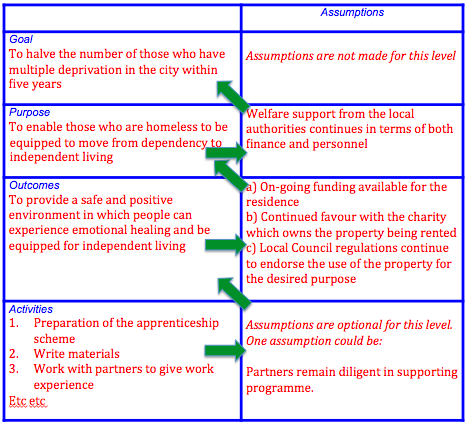
Having seen the importance of recognising the assumptions we are making in planning a specific ministry we will now return to the example we have been using to illustrate how to use the Logframe, the ministry among homeless people in Brighton. We will consider some of the assumptions that must apply for success at each level.
Positive Statements
Assumptions should be expressed as positive statements to show how each level of the Logframe will contribute to the successful accomplishment of the next level up, particularly Outcomes > Purpose and Purpose > Goal.
Assumptions relate to adverse situations that could arise or conditions that cannot be met due to external circumstances. They may or may not be included on the Logframe at the Activities level since the Activities are generally in the control of the Ministry team.
For a successful Purpose assumptions about Outcomes might relate to a) on-going funding for the particular residence b) continued favour with the charity which owns the property being rented for this purpose c) no changes in local council regulations that affect the use of the property for the desired purpose.
Next, successful achievement of the ultimate Goal may be dependent on the on-going provision of welfare support from the local authorities in terms of both finance and personnel for the Purpose.
The Goal does not itself have further assumptions – if everything else has been achieved the Goal has been accomplished.
When entering these conditions on the chart they should be expressed as positive statements, as shown. The diagram below shows the flow between the assumptions and each higher level.
Identifying assumptions in this way can save a lot of heartache, avoiding the pain which results from unrecognised things going wrong that could have been anticipated or at least acknowledged as possibilities. They are particularly important for potential funders as they represent a measure of risk
In the next blog we shall consider how progress is monitored.

